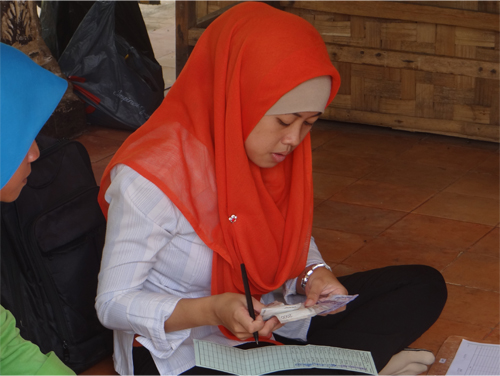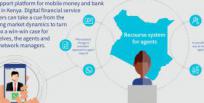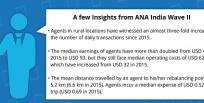
Click here to read the blog in Bahasa
Last year, The Helix Institute discussed the importance of focusing on the “Launchpad Stage” before rolling out a DFS deployment. The Launchpad Stage is the developmental phase which concentrates on identifying a value proposition in the market, defining an anchor product, designing processes, structuring management, streamlining protocols and crafting a marketing and communications strategy.
In Nigeria, providers seemed to have skipped the Launchpad Stage, and attempted to scale without strategic clarity. In Indonesia, regulatory uncertainly has kept all the big players from investing to scale aggressively; however, with the newly released regulation at the end of 2014, that may soon change. The viability of commonly used anchor products is still unclear in the face of low levels of market research, meaning initial attempts at on-boarding agents are disjointed, and the ability to register customers through them, and therefore scale effectively, is extremely limited.
Indonesian Regulatory Environment
E-money regulation (No.11/12/PBI/2009), issued by the Central Bank of Indonesia (Bank Indonesia), permits only big banks with a capital of more than US$ 2.5 billion—known as Book IV Banks— to build agent networks of small individual stores as done in East Africa. Meanwhile smaller banks and MNOs can only partner with registered legal entities, such as convenience chain stores. As a result, MNOs and small banks are struggling to scale up operations and expand their footprint into the rural areas where many of these unregistered entities (such as small mom and pop shops) are found.
For MNOs and small banks wanting to offer money transfers/person to person (P2P) transfers where scale and density are needed to reach dispersive populations, this restriction can be a challenge. Helix research in East Africa demonstrates that small individual entities played a major role in spreading DFS footprint especially in rural areas. According to the research, 53% and 31% of agents in Tanzania and Kenya respectively, operate small general stores (considered unregistered entities in Indonesia).
Remittances & Bill Payments are Pervasive, but not the Corresponding DFS Products
In a 2013 Gallup survey, 83% of Indonesian respondents reported sending or receiving a remittance or payment transaction, and 57% of them used informal mechanisms to send the cash, such as through family members, friends, or informal money couriers. A sender typically sent $87.40 (International Dollars [1]) domestically about 1.6 times a month. Yet currently, mobile wallet customers can only withdraw their money from the system once they are registered, and Helix research found that service providers are not providing clear incentives to agents to register customers. Interviews with agents indicated that many found registration burdensome and some MNOs only offered registration at a minority of their outlets—primarily in urban areas.
Furthermore, the research demonstrated that whilst agents had marketing collateral, they were not targeted towards specific segments of the population (i.e. rural women, illiterate labourers). Robust market research and sophisticated customer segmentation has not been done to ensure that products are positioned correctly for customers. In fact, only 3% of Indonesians are aware of mobile money services and only 0.1% has used them. It seems that Indonesians are not aware of how DFS can provide an alternative to their remittance and payments needs.
Having said that however, Indonesia has more than 50,000 over the counter (OTC) bill payment providers that are present in urban and rural areas. Some banks are partnering with these providers and present a good opportunity to DFS providers to scale quickly. However, as bill payment providers can serve customers without integrating with a DFS provider, interested players will have to find clever ways to add value to an already popular service.

Focused Internal Teams and Agent Selection
Once providers define their anchor product, it is necessary to structure management and design protocols and processes around this. Though the interviews shed light on one provider’s best practice in DFS team alignment and agent selection, many service providers’ internal teams were shared between departments, leaving no one solely focused on driving success, and breeding confusion between departments as to who was ultimately responsible for outcomes.
Additionally, agent selection seems a bit haphazard as opposed to searching for key demographics that are aligned with the prevailing value proposition. Agents varied from government officers, airtime distributors, to convenience store agents who did not have a clear understanding of DFS or in some cases even understand how to operate a mobile phone. Agent demographics need to be customized to specific value propositions and the tasks they will be asked to execute (i.e. customer enrollment).
Launching to Success
The new regulatory policy seems to unfairly favor the big banks, but at least for now it gives more clarity to the arsenal of players that have been showing interest in this space, yet reluctant to invest. However, pilots of the past have been worryingly small, and initial attempts at building agent networks on small scales do not seem governed by well researched strategies. Indonesia is still in the Launchpad Stage, and it is hopeful to see all the big banks and telecoms there, interested in garnering market share. However, before big investments are made, it does seem that more strategic clarity is needed.
[1] The Gallup report uses International Dollars (ID) to compare payment and remittance amounts across the countries studied. The source of ID comes from: Global Purchasing Power Parities and Real Expenditures: 2005 International Comparison Program. Rep. World Bank, 2008. Web. 17 Dec. 2012. www.siteresources.worldbank.org/ICPINT/Resources/icp-final.pdf. Gallup used Global Purchasing Power Parities and Real Expenditures: 2005 International Comparison Program to compare currencies and exchange rates across countries and time using the baseline year of 2005.











